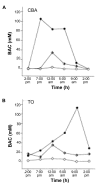Chronobiological regulation of alcohol intake
- PMID: 11584553
- PMCID: PMC6707129
Chronobiological regulation of alcohol intake
Abstract
Like other physiological functions, food intake and metabolism (including alcohol consumption) in humans and animal models may be regulated by circadian rhythm. For example, many studies of rodents have found that alcohol consumption in these nocturnal animals peaks during their active dark period. This alcohol consumption pattern can be influenced, however, by experimental manipulation. One factor that has been proposed to play a role in regulating circadian alcohol consumption pattern is the hormone melatonin, which is produced by the pineal gland. Research also indicates that the effects of lighting conditions on the alcohol consumption of animal models may be influenced by the differences among the strains of the laboratory animals used, variations in the type and administration schedule of the animals' alcohol-containing diet, disruptions of the normal circadian rhythm, concurrent use of other drugs, and properties of the light.
Figures


Similar articles
-
Repeated light-dark phase shifts modulate voluntary ethanol intake in male and female high alcohol-drinking (HAD1) rats.Alcohol Clin Exp Res. 2007 Oct;31(10):1699-706. doi: 10.1111/j.1530-0277.2007.00476.x. Epub 2007 Aug 6. Alcohol Clin Exp Res. 2007. PMID: 17681032
-
Circadian drinking pattern of Sardinian alcohol-preferring rats.Alcohol Alcohol. 1996 Jul;31(4):385-8. doi: 10.1093/oxfordjournals.alcalc.a008166. Alcohol Alcohol. 1996. PMID: 8879286
-
Alcohol consumption does not affect melatonin circadian synchronization in healthy men.Alcohol Alcohol. 2006 Jul-Aug;41(4):386-90. doi: 10.1093/alcalc/agl036. Epub 2006 May 5. Alcohol Alcohol. 2006. PMID: 16679342
-
Melatonin as a time-meaningful signal in circadian organization of immune response.Biol Signals Recept. 1999 Jan-Apr;8(1-2):41-8. doi: 10.1159/000014567. Biol Signals Recept. 1999. PMID: 10085461 Review.
-
Melatonin, the pineal gland, and circadian rhythms.J Biol Rhythms. 1993;8 Suppl:S73-81. J Biol Rhythms. 1993. PMID: 8274765 Review.
Cited by
-
Disrupted Circadian Rhythms and Substance Use Disorders: A Narrative Review.Clocks Sleep. 2024 Aug 19;6(3):446-467. doi: 10.3390/clockssleep6030030. Clocks Sleep. 2024. PMID: 39189197 Free PMC article. Review.
-
Effects of stress on alcohol drinking: a review of animal studies.Psychopharmacology (Berl). 2011 Nov;218(1):131-56. doi: 10.1007/s00213-011-2443-9. Epub 2011 Aug 18. Psychopharmacology (Berl). 2011. PMID: 21850445 Free PMC article. Review.
-
Circadian and acamprosate modulation of elevated ethanol drinking in mPer2 clock gene mutant mice.Chronobiol Int. 2011 Oct;28(8):664-72. doi: 10.3109/07420528.2011.601968. Chronobiol Int. 2011. PMID: 21929298 Free PMC article.
-
A simple high-throughput method for automated detection of Drosophila melanogaster light-dependent behaviours.BMC Biol. 2022 Dec 17;20(1):283. doi: 10.1186/s12915-022-01476-z. BMC Biol. 2022. PMID: 36527001 Free PMC article.
-
Chronic ethanol consumption exacerbates future stress-enhanced fear learning, an effect mediated by dorsal hippocampal astrocytes.Alcohol Clin Exp Res. 2022 Dec;46(12):2177-2190. doi: 10.1111/acer.14963. Epub 2022 Nov 9. Alcohol Clin Exp Res. 2022. PMID: 36349797 Free PMC article.
References
-
- Aalto J. Circadian drinking rhythms and blood alcohol levels in two rat lines developed for their alcohol consumption. Alcohol. 1986;3(1):73–75. - PubMed
-
- Agabio R, Cortis G, Fadda F, et al. Circadian drinking pattern of Sardinian alcohol-preferring rats. Alcohol & Alcoholism. 1996;31(4):385–388. - PubMed
-
- Blum K, Merritt JH, Reiter RJ, Wallace JE. A possible relationship between the pineal gland and ethanol preference in the rat. Current Therapeutic Research. 1973;15(1):25–30. - PubMed
-
- Boyle AEL, Smith BR, Amit Z. A descriptive analysis of the structure and temporal pattern of voluntary ethanol intake within an acquisition paradigm. Journal of Studies on Alcohol. 1997;58:382–391. - PubMed
-
- Burke LP, Kramer SZ. Effects of photoperiod, melatonin and pinealectomy on ethanol consumption in rats. Pharmacology Biochemistry and Behavior. 1974;2(4):459–463. - PubMed
Publication types
MeSH terms
Substances
LinkOut - more resources
Full Text Sources
Medical
